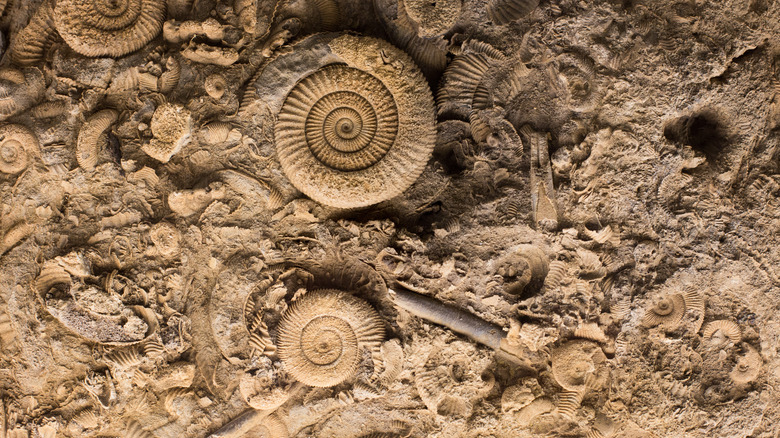This 500-Million-Year-Old Fossil Looks Like Something Out Of A Sci-Fi Novel
While scientists have found some pretty strange fossils over the years, nothing could have prepared them for the discovery of a 500-million-year-old fossilized sea creature that once had three eyes. This sci-fi adjacent discovery was even more amazing when scientists found an impressive total of 84 fossilized remains of the creature in the Burgess Shale, with some of the specimens even having preserved brains and nervous systems (via IFL Science).
The creature in question is one Stanleycaris hirpex, a bizarre predator that hunted for prey in the oceans during the Cambrian Period (via Live Science). The statement announcing the discovery and study of the Stanleycaris fossils was published in Eureka Alert by the Royal Ontario museum. In the statement, researchers announced that the remains of Stanleycaris that were found have been dated back 506 million years. There are several factors of this discovery that make Stanleycaris hirpex a puzzling ancient creature that once lived in our oceans.
Researchers believe the third eye helped with hunting
Perhaps the strangest part of Stanleycaris hirpex is that fact that it has not one, not two, but three eyes. Interestingly, Stanleycaris hirpex lived during the Cambrian Period, a time shortly after the first eyes appear on the fossil record. According to New Scientist, Stanleycaris may have been the first arthropod to have three eyes. Modern arthropods include insects, spiders, and crustaceans.
According to Joseph Moysiuk, lead author of the study revealing the findings of Stanleycaris hirpex, the third eye was unexpected. "Finding the third eye was quite a shock to us because we were starting to think we understood radiodonts and what they looked like pretty well," Moysiuk stated (via Live Science). While the exact use of the third eye is still unknown, Moysiuk and his team have some theories, "we can only speculate, but we think that this third eye helped with orienting an animal, and it's especially important for a predator like Stanleycaris that has to move around rapidly and precisely in the environment."
Dozens of fossil specimens of Stanleycaris hirpex exist
In addition to the unexpected discovery of Stanleycaris hirpex's third eye, researchers were also astonished to discover a whopping 84 specimens (via IFL Science). Not only that, but many of the fossils also had intact brains and nervous systems. According to lead researcher Joseph Moysiuk, "what makes this find so remarkable is that we have dozens of specimens showing the remains of the brain and... nervous system, and they're incredibly well preserved" (via Live Science).
Looking at Stanleycaris under a microscope, Moysiuk and his team were able to see its brain in amazing detail. They found that the creature's brain was made of two segments known as the protocerebrum and deutocerebrum. According to ABC News, the team was able to see that the deutocerebrum contained bundles of nerves that used to connect to Stanleycaris' claws and eyes. The findings of this creature, published in Current Biology, may help researchers fill out the evolutionary tree, connecting the dots between ancient creatures like Stanleycaris hirpex and today's animals.


